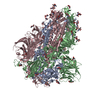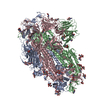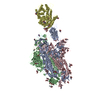[English] 日本語
 Yorodumi
Yorodumi- EMDB-35625: SARS-CoV-2 XBB.1 spike glycoprotein in complex with ACE2 (2-up state) -
+ Open data
Open data
- Basic information
Basic information
| Entry |  | |||||||||||||||||||||
|---|---|---|---|---|---|---|---|---|---|---|---|---|---|---|---|---|---|---|---|---|---|---|
| Title | SARS-CoV-2 XBB.1 spike glycoprotein in complex with ACE2 (2-up state) | |||||||||||||||||||||
 Map data Map data | ||||||||||||||||||||||
 Sample Sample |
| |||||||||||||||||||||
 Keywords Keywords |  spike glycoprotein / spike glycoprotein /  VIRAL PROTEIN / VIRAL PROTEIN /  VIRAL PROTEIN-PROTEIN BINDING complex VIRAL PROTEIN-PROTEIN BINDING complex | |||||||||||||||||||||
| Biological species |   Severe acute respiratory syndrome coronavirus 2 / Severe acute respiratory syndrome coronavirus 2 /   Homo sapiens (human) Homo sapiens (human) | |||||||||||||||||||||
| Method |  single particle reconstruction / single particle reconstruction /  cryo EM / Resolution: 2.99 Å cryo EM / Resolution: 2.99 Å | |||||||||||||||||||||
 Authors Authors | Anraku Y / Kita S / Yajima H / Sasaki J / Sasaki-Tabata K / Maenaka K / Hashiguchi T | |||||||||||||||||||||
| Funding support |  Japan, 6 items Japan, 6 items
| |||||||||||||||||||||
 Citation Citation |  Journal: Nat Commun / Year: 2023 Journal: Nat Commun / Year: 2023Title: Virological characteristics of the SARS-CoV-2 XBB variant derived from recombination of two Omicron subvariants. Authors: Tomokazu Tamura / Jumpei Ito / Keiya Uriu / Jiri Zahradnik / Izumi Kida / Yuki Anraku / Hesham Nasser / Maya Shofa / Yoshitaka Oda / Spyros Lytras / Naganori Nao / Yukari Itakura / Sayaka ...Authors: Tomokazu Tamura / Jumpei Ito / Keiya Uriu / Jiri Zahradnik / Izumi Kida / Yuki Anraku / Hesham Nasser / Maya Shofa / Yoshitaka Oda / Spyros Lytras / Naganori Nao / Yukari Itakura / Sayaka Deguchi / Rigel Suzuki / Lei Wang / Mst Monira Begum / Shunsuke Kita / Hisano Yajima / Jiei Sasaki / Kaori Sasaki-Tabata / Ryo Shimizu / Masumi Tsuda / Yusuke Kosugi / Shigeru Fujita / Lin Pan / Daniel Sauter / Kumiko Yoshimatsu / Saori Suzuki / Hiroyuki Asakura / Mami Nagashima / Kenji Sadamasu / Kazuhisa Yoshimura / Yuki Yamamoto / Tetsuharu Nagamoto / Gideon Schreiber / Katsumi Maenaka / / Takao Hashiguchi / Terumasa Ikeda / Takasuke Fukuhara / Akatsuki Saito / Shinya Tanaka / Keita Matsuno / Kazuo Takayama / Kei Sato /      Abstract: In late 2022, SARS-CoV-2 Omicron subvariants have become highly diversified, and XBB is spreading rapidly around the world. Our phylogenetic analyses suggested that XBB emerged through the ...In late 2022, SARS-CoV-2 Omicron subvariants have become highly diversified, and XBB is spreading rapidly around the world. Our phylogenetic analyses suggested that XBB emerged through the recombination of two cocirculating BA.2 lineages, BJ.1 and BM.1.1.1 (a progeny of BA.2.75), during the summer of 2022. XBB.1 is the variant most profoundly resistant to BA.2/5 breakthrough infection sera to date and is more fusogenic than BA.2.75. The recombination breakpoint is located in the receptor-binding domain of spike, and each region of the recombinant spike confers immune evasion and increases fusogenicity. We further provide the structural basis for the interaction between XBB.1 spike and human ACE2. Finally, the intrinsic pathogenicity of XBB.1 in male hamsters is comparable to or even lower than that of BA.2.75. Our multiscale investigation provides evidence suggesting that XBB is the first observed SARS-CoV-2 variant to increase its fitness through recombination rather than substitutions. | |||||||||||||||||||||
| History |
|
- Structure visualization
Structure visualization
| Supplemental images |
|---|
- Downloads & links
Downloads & links
-EMDB archive
| Map data |  emd_35625.map.gz emd_35625.map.gz | 108.7 MB |  EMDB map data format EMDB map data format | |
|---|---|---|---|---|
| Header (meta data) |  emd-35625-v30.xml emd-35625-v30.xml emd-35625.xml emd-35625.xml | 24.1 KB 24.1 KB | Display Display |  EMDB header EMDB header |
| FSC (resolution estimation) |  emd_35625_fsc.xml emd_35625_fsc.xml | 12.7 KB | Display |  FSC data file FSC data file |
| Images |  emd_35625.png emd_35625.png | 80.3 KB | ||
| Masks |  emd_35625_msk_1.map emd_35625_msk_1.map | 216 MB |  Mask map Mask map | |
| Filedesc metadata |  emd-35625.cif.gz emd-35625.cif.gz | 7.3 KB | ||
| Others |  emd_35625_half_map_1.map.gz emd_35625_half_map_1.map.gz emd_35625_half_map_2.map.gz emd_35625_half_map_2.map.gz | 200.4 MB 200.4 MB | ||
| Archive directory |  http://ftp.pdbj.org/pub/emdb/structures/EMD-35625 http://ftp.pdbj.org/pub/emdb/structures/EMD-35625 ftp://ftp.pdbj.org/pub/emdb/structures/EMD-35625 ftp://ftp.pdbj.org/pub/emdb/structures/EMD-35625 | HTTPS FTP |
-Related structure data
- Links
Links
| EMDB pages |  EMDB (EBI/PDBe) / EMDB (EBI/PDBe) /  EMDataResource EMDataResource |
|---|
- Map
Map
| File |  Download / File: emd_35625.map.gz / Format: CCP4 / Size: 216 MB / Type: IMAGE STORED AS FLOATING POINT NUMBER (4 BYTES) Download / File: emd_35625.map.gz / Format: CCP4 / Size: 216 MB / Type: IMAGE STORED AS FLOATING POINT NUMBER (4 BYTES) | ||||||||||||||||||||
|---|---|---|---|---|---|---|---|---|---|---|---|---|---|---|---|---|---|---|---|---|---|
| Voxel size | X=Y=Z: 1.005 Å | ||||||||||||||||||||
| Density |
| ||||||||||||||||||||
| Symmetry | Space group: 1 | ||||||||||||||||||||
| Details | EMDB XML:
|
-Supplemental data
-Mask #1
| File |  emd_35625_msk_1.map emd_35625_msk_1.map | ||||||||||||
|---|---|---|---|---|---|---|---|---|---|---|---|---|---|
| Projections & Slices |
| ||||||||||||
| Density Histograms |
-Half map: #1
| File | emd_35625_half_map_1.map | ||||||||||||
|---|---|---|---|---|---|---|---|---|---|---|---|---|---|
| Projections & Slices |
| ||||||||||||
| Density Histograms |
-Half map: #2
| File | emd_35625_half_map_2.map | ||||||||||||
|---|---|---|---|---|---|---|---|---|---|---|---|---|---|
| Projections & Slices |
| ||||||||||||
| Density Histograms |
- Sample components
Sample components
-Entire : SARS-COV-2 XBB.1 spike glycoprotein in complex with ACE2
| Entire | Name: SARS-COV-2 XBB.1 spike glycoprotein in complex with ACE2 |
|---|---|
| Components |
|
-Supramolecule #1: SARS-COV-2 XBB.1 spike glycoprotein in complex with ACE2
| Supramolecule | Name: SARS-COV-2 XBB.1 spike glycoprotein in complex with ACE2 type: complex / ID: 1 / Parent: 0 / Macromolecule list: all |
|---|---|
| Molecular weight | Theoretical: 600 KDa |
-Supramolecule #2: SARS-CoV-2 XBB.1 spike glycoprotein
| Supramolecule | Name: SARS-CoV-2 XBB.1 spike glycoprotein / type: complex / ID: 2 / Parent: 1 / Macromolecule list: #1 |
|---|---|
| Source (natural) | Organism:   Severe acute respiratory syndrome coronavirus 2 Severe acute respiratory syndrome coronavirus 2 |
| Molecular weight | Theoretical: 420 KDa |
-Supramolecule #3: Angiotensin-converting enzyme 2
| Supramolecule | Name: Angiotensin-converting enzyme 2 / type: complex / ID: 3 / Parent: 1 / Macromolecule list: #2 |
|---|---|
| Source (natural) | Organism:   Homo sapiens (human) Homo sapiens (human) |
| Molecular weight | Theoretical: 90 KDa |
-Macromolecule #1: SARS-CoV-2 XBB.1 spike glycoprotein
| Macromolecule | Name: SARS-CoV-2 XBB.1 spike glycoprotein / type: protein_or_peptide / ID: 1 / Enantiomer: LEVO |
|---|---|
| Source (natural) | Organism:   Severe acute respiratory syndrome coronavirus 2 Severe acute respiratory syndrome coronavirus 2 |
| Recombinant expression | Organism:   Homo sapiens (human) Homo sapiens (human) |
| Sequence | String: LLMGCVAETG SSQCVNLITR TQSYTNSFTR GVYYPDKVFR SSVLHSTQDL FLPFFSNVTW FHAIHVSGTN GTKRFDNPAL PFNDGVYFAS TEKSNIIRGW IFGTTLDSKT QSLLIVNNAT NVVIKVCEFQ FCNDPFLDVY QKNNKSWMES EFRVYSSANN CTFEYVSQPF ...String: LLMGCVAETG SSQCVNLITR TQSYTNSFTR GVYYPDKVFR SSVLHSTQDL FLPFFSNVTW FHAIHVSGTN GTKRFDNPAL PFNDGVYFAS TEKSNIIRGW IFGTTLDSKT QSLLIVNNAT NVVIKVCEFQ FCNDPFLDVY QKNNKSWMES EFRVYSSANN CTFEYVSQPF LMDLEGKEGN FKNLREFVFK NIDGYFKIYS KHTPINLERD LPQGFSALEP LVDLPIGINI TRFQTLLALH RSYLTPVDSS SGWTAGAAAY YVGYLQPRTF LLKYNENGTI TDAVDCALDP LSETKCTLKS FTVEKGIYQT SNFRVQPTES IVRFPNITNL CPFHEVFNAT TFASVYAWNR KRISNCVADY SVIYNFAPFF AFKCYGVSPT KLNDLCFTNV YADSFVIRGN EVSQIAPGQT GNIADYNYKL PDDFTGCVIA WNSNKLDSKP SGNYNYLYRL FRKSKLKPFE RDISTEIYQA GNKPCNGVAG SNCYSPLQSY GFRPTYGVGH QPYRVVVLSF ELLHAPATVC GPKKSTNLVK NKCVNFNFNG LTGTGVLTES NKKFLPFQQF GRDIADTTDA VRDPQTLEIL DITPCSFGGV SVITPGTNTS NQVAVLYQGV NCTEVPVAIH ADQLTPTWRV YSTGSNVFQT RAGCLIGAEY VNNSYECDIP IGAGICASYQ TQTKSHGSAG SVASQSIIAY TMSLGAENSV AYSNNSIAIP TNFTISVTTE ILPVSMTKTS VDCTMYICGD STECSNLLLQ YGSFCTQLKR ALTGIAVEQD KNTQEVFAQV KQIYKTPPIK YFGGFNFSQI LPDPSKPSKR SPIEDLLFNK VTLADAGFIK QYGDCLGDIA ARDLICAQKF NGLTVLPPLL TDEMIAQYTS ALLAGTITSG WTFGAGPALQ IPFPMQMAYR FNGIGVTQNV LYENQKLIAN QFNSAIGKIQ DSLSSTPSAL GKLQDVVNHN AQALNTLVKQ LSSKFGAISS VLNDILSRLD PPEAEVQIDR LITGRLQSLQ TYVTQQLIRA AEIRASANLA ATKMSECVLG QSKRVDFCGK GYHLMSFPQS APHGVVFLHV TYVPAQEKNF TTAPAICHDG KAHFPREGVF VSNGTHWFVT QRNFYEPQII TTDNTFVSGN CDVVIGIVNN TVYDPLQPEL DSFKEELDKY FKNHTSPDVD LGDISGINAS VVNIQKEIDR LNEVAKNLNE SLIDLQELGK YEQYIASSGY IPEAPRDGQA YVRKDGEWVL LSTFLEGTKH HHHHH |
-Macromolecule #2: Angiotensin-converting enzyme 2
| Macromolecule | Name: Angiotensin-converting enzyme 2 / type: protein_or_peptide / ID: 2 / Enantiomer: LEVO |
|---|---|
| Source (natural) | Organism:   Homo sapiens (human) Homo sapiens (human) |
| Recombinant expression | Organism:   Homo sapiens (human) Homo sapiens (human) |
| Sequence | String: STIEEQAKTF LDKFNHEAED LFYQSSLASW NYNTNITEEN VQNMNNAGDK WSAFLKEQST LAQMYPLQEI QNLTVKLQLQ ALQQNGSSVL SEDKSKRLNT ILNTMSTIYS TGKVCNPDNP QECLLLEPGL NEIMANSLDY NERLWAWESW RSEVGKQLRP LYEEYVVLKN ...String: STIEEQAKTF LDKFNHEAED LFYQSSLASW NYNTNITEEN VQNMNNAGDK WSAFLKEQST LAQMYPLQEI QNLTVKLQLQ ALQQNGSSVL SEDKSKRLNT ILNTMSTIYS TGKVCNPDNP QECLLLEPGL NEIMANSLDY NERLWAWESW RSEVGKQLRP LYEEYVVLKN EMARANHYED YGDYWRGDYE VNGVDGYDYS RGQLIEDVEH TFEEIKPLYE HLHAYVRAKL MNAYPSYISP IGCLPAHLLG DMWGRFWTNL YSLTVPFGQK PNIDVTDAMV DQAWDAQRIF KEAEKFFVSV GLPNMTQGFW ENSMLTDPGN VQKAVCHPTA WDLGKGDFRI LMCTKVTMDD FLTAHHEMGH IQYDMAYAAQ PFLLRNGANE GFHEAVGEIM SLSAATPKHL KSIGLLSPDF QEDNETEINF LLKQALTIVG TLPFTYMLEK WRWMVFKGEI PKDQWMKKWW EMKREIVGVV EPVPHDETYC DPASLFHVSN DYSFIRYYTR TLYQFQFQEA LCQAAKHEGP LHKCDISNST EAGQKLFNML RLGKSEPWTL ALENVVGAKN MNVRPLLNYF EPLFTWLKDQ NKNSFVGWST DWSPYADQSG TKHHHHHH |
-Experimental details
-Structure determination
| Method |  cryo EM cryo EM |
|---|---|
 Processing Processing |  single particle reconstruction single particle reconstruction |
| Aggregation state | particle |
- Sample preparation
Sample preparation
| Buffer | pH: 7.4 / Details: calcium- and magnesium-free PBS buffer. |
|---|---|
| Grid | Model: Quantifoil R2/2 / Material: COPPER / Mesh: 300 / Pretreatment - Type: GLOW DISCHARGE / Pretreatment - Time: 60 sec. / Pretreatment - Atmosphere: AIR |
| Vitrification | Cryogen name: ETHANE / Chamber humidity: 100 % / Chamber temperature: 291 K / Instrument: FEI VITROBOT MARK IV / Details: blotting time 5 s and blotting force 5.. |
- Electron microscopy
Electron microscopy
| Microscope | TFS KRIOS |
|---|---|
| Electron beam | Acceleration voltage: 300 kV / Electron source:  FIELD EMISSION GUN FIELD EMISSION GUN |
| Electron optics | Illumination mode: FLOOD BEAM / Imaging mode: BRIGHT FIELD Bright-field microscopy / Cs: 2.7 mm / Nominal defocus max: 1.8 µm / Nominal defocus min: 0.8 µm / Nominal magnification: 130000 Bright-field microscopy / Cs: 2.7 mm / Nominal defocus max: 1.8 µm / Nominal defocus min: 0.8 µm / Nominal magnification: 130000 |
| Specialist optics | Energy filter - Name: GIF Bioquantum / Energy filter - Slit width: 20 eV |
| Sample stage | Specimen holder model: FEI TITAN KRIOS AUTOGRID HOLDER / Cooling holder cryogen: NITROGEN |
| Image recording | Film or detector model: GATAN K3 BIOQUANTUM (6k x 4k) / Digitization - Dimensions - Width: 5760 pixel / Digitization - Dimensions - Height: 4092 pixel / Number real images: 7402 / Average exposure time: 1.5 sec. / Average electron dose: 50.4 e/Å2 |
| Experimental equipment |  Model: Titan Krios / Image courtesy: FEI Company |
 Movie
Movie Controller
Controller











 Z
Z Y
Y X
X


























